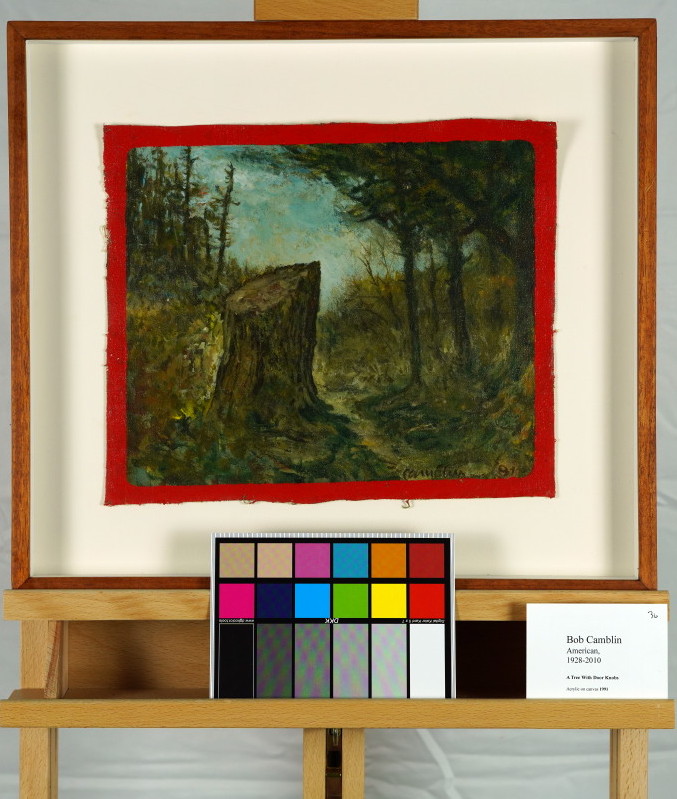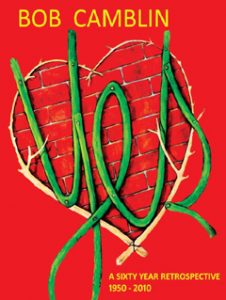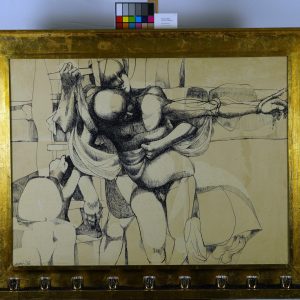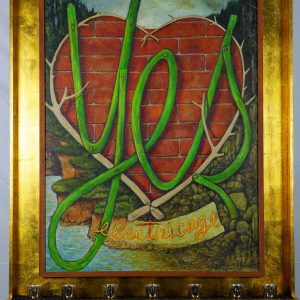Description
A Tree With Door Knobs, 1991Acrylic on paper
Signed
11 x 13 in. (image)
16.5 x 18.5 x 2 in. (frame)
original, includes certificate of authenticity from ArtTrust
“A Tree With Door Knobs” depicts a rugged landscape with a forest setting and a prominent tree stump in the foreground. The brushwork captures the texture of the foliage and the stump, creating a rich, organic atmosphere. The composition seems to invite the viewer to ponder the story behind the scene and the passage of time it reflects.
In Zen philosophy, the forest symbolizes the essence of nature’s impermanence. The tree stump at the center of the image acts as a metaphor for the inevitability of change—an emblem of life’s cycles of birth, decay, and renewal. In the stillness of this natural setting, one may encounter the Zen idea of “Mu” (emptiness), as the scene prompts a reflection on what remains when life ends and what transformations arise thereafter.
This painting evokes the hexagram 23, “Splitting Apart” (剝, Bō), which symbolizes decay or decomposition, followed by regeneration. The tree stump is reminiscent of this idea, representing an end to an old state of being and the emergence of a new phase. It conveys the necessity of letting go and the understanding that from what is broken down, there can be renewal. The forest surrounding the stump suggests potential for growth, underscoring the I Ching’s themes of cyclical nature and transformation.
The interplay between the Zen notion of impermanence and the I Ching’s theme of “Splitting Apart” harmonizes in this artwork. The stump, once a tree full of life, stands as a reminder that endings can also be beginnings, embracing the inevitability of life’s cycles. The rough textures and dark colors used in the painting evoke a rawness and authenticity, emphasizing that even in the most humble states, there lies a profound beauty and quiet dignity. The red border might symbolize vitality or the boundary between the inner and outer worlds, inviting contemplation on the transient nature of existence and our place within it.
The technique and subject matter are reminiscent of the late 19th-century realism with a touch of romanticism, which sought to depict nature in its unembellished form while also conveying a sense of spiritual or emotional resonance. The artist’s choice of a vivid red border frames the scene in a modern twist, drawing the viewer’s eye inward and adding a symbolic element that could be interpreted as life force or energy encircling the scene. The work aligns with traditions that explore nature as a mirror for human experience, reflecting the influences of artists who embraced both naturalistic detail and expressive potential.
*Shipping cost will vary, please inquire at sales@camblingallery.com before purchasing.
Currently ships from Oregon, USA
Member of artnet? Apply for a discount! Inquire about intergallery and permanent loans for museums.
“A Tree With Door Knobs” was featured in his Yes Retrospective
Reproductions of this drawing are available in multiple sizes!
Click here to use our high-resolution viewer!
This artwork is available with a non-fungible token to ensure traceability and transparency of provenance.
The royalty factor – Unlike traditional artworks, such as paintings, mosaics, statues, and the like, NFTs can be programmed to provide royalties to you every time the painting (and token) is sold and resold – for eternity. That mind-bending Camblin you sold could be worth millions one day and provide income for your great-great-great grandkids!
Anti-forgery – The central idea underpinning NFTs is that they are built on the blockchain, which is meant to offer advanced security. Think of it like an un-erasable and un-avoidable copyright.
Easy authentication – Another compelling aspect of NFT art and NFTs in general is the ability to quickly and easily authenticate items, as the record of ownership is scrupulously kept on the blockchain.





